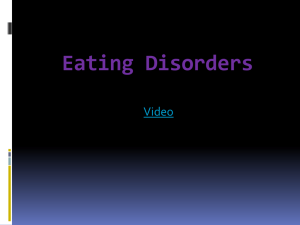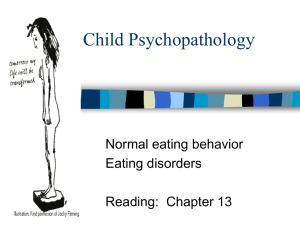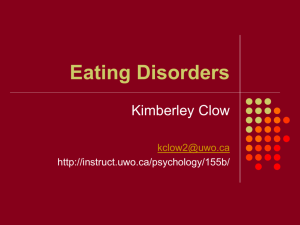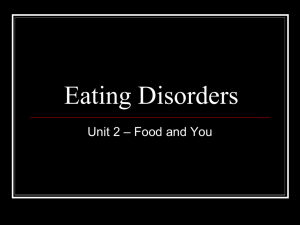Document 13310513
advertisement
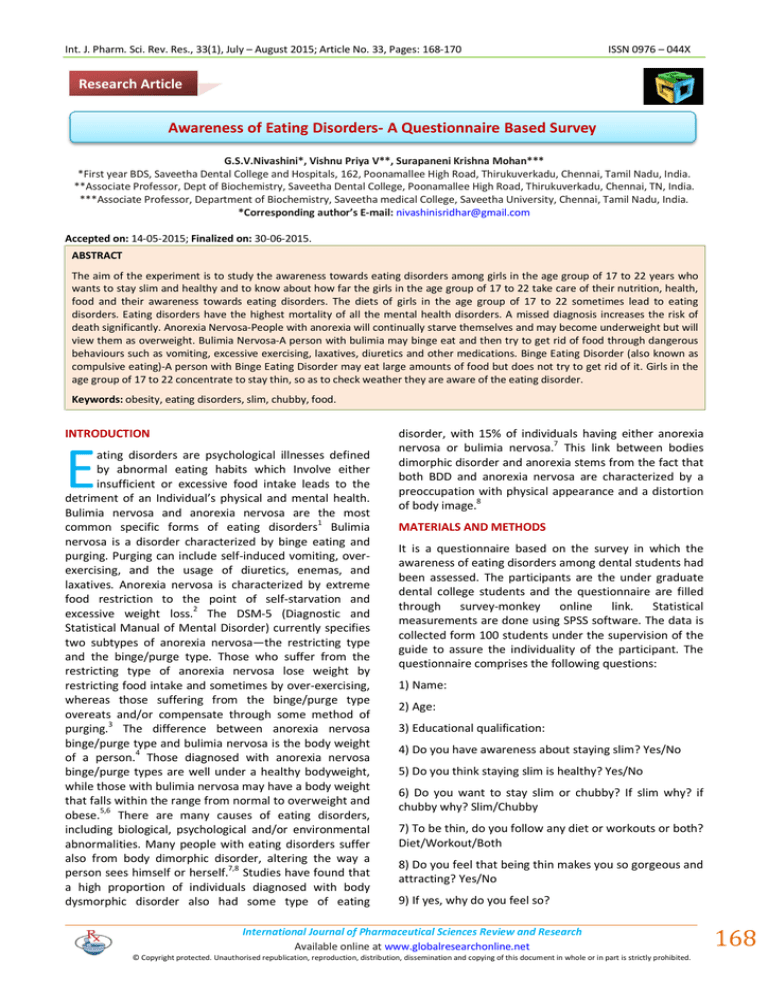
Int. J. Pharm. Sci. Rev. Res., 33(1), July – August 2015; Article No. 33, Pages: 168-170 ISSN 0976 – 044X Research Article Awareness of Eating Disorders- A Questionnaire Based Survey G.S.V.Nivashini*, Vishnu Priya V**, Surapaneni Krishna Mohan*** *First year BDS, Saveetha Dental College and Hospitals, 162, Poonamallee High Road, Thirukuverkadu, Chennai, Tamil Nadu, India. **Associate Professor, Dept of Biochemistry, Saveetha Dental College, Poonamallee High Road, Thirukuverkadu, Chennai, TN, India. ***Associate Professor, Department of Biochemistry, Saveetha medical College, Saveetha University, Chennai, Tamil Nadu, India. *Corresponding author’s E-mail: nivashinisridhar@gmail.com Accepted on: 14-05-2015; Finalized on: 30-06-2015. ABSTRACT The aim of the experiment is to study the awareness towards eating disorders among girls in the age group of 17 to 22 years who wants to stay slim and healthy and to know about how far the girls in the age group of 17 to 22 take care of their nutrition, health, food and their awareness towards eating disorders. The diets of girls in the age group of 17 to 22 sometimes lead to eating disorders. Eating disorders have the highest mortality of all the mental health disorders. A missed diagnosis increases the risk of death significantly. Anorexia Nervosa-People with anorexia will continually starve themselves and may become underweight but will view them as overweight. Bulimia Nervosa-A person with bulimia may binge eat and then try to get rid of food through dangerous behaviours such as vomiting, excessive exercising, laxatives, diuretics and other medications. Binge Eating Disorder (also known as compulsive eating)-A person with Binge Eating Disorder may eat large amounts of food but does not try to get rid of it. Girls in the age group of 17 to 22 concentrate to stay thin, so as to check weather they are aware of the eating disorder. Keywords: obesity, eating disorders, slim, chubby, food. INTRODUCTION E ating disorders are psychological illnesses defined by abnormal eating habits which Involve either insufficient or excessive food intake leads to the detriment of an Individual’s physical and mental health. Bulimia nervosa and anorexia nervosa are the most common specific forms of eating disorders1 Bulimia nervosa is a disorder characterized by binge eating and purging. Purging can include self-induced vomiting, overexercising, and the usage of diuretics, enemas, and laxatives. Anorexia nervosa is characterized by extreme food restriction to the point of self-starvation and excessive weight loss.2 The DSM-5 (Diagnostic and Statistical Manual of Mental Disorder) currently specifies two subtypes of anorexia nervosa—the restricting type and the binge/purge type. Those who suffer from the restricting type of anorexia nervosa lose weight by restricting food intake and sometimes by over-exercising, whereas those suffering from the binge/purge type overeats and/or compensate through some method of 3 purging. The difference between anorexia nervosa binge/purge type and bulimia nervosa is the body weight 4 of a person. Those diagnosed with anorexia nervosa binge/purge types are well under a healthy bodyweight, while those with bulimia nervosa may have a body weight that falls within the range from normal to overweight and obese.5,6 There are many causes of eating disorders, including biological, psychological and/or environmental abnormalities. Many people with eating disorders suffer also from body dimorphic disorder, altering the way a person sees himself or herself.7,8 Studies have found that a high proportion of individuals diagnosed with body dysmorphic disorder also had some type of eating disorder, with 15% of individuals having either anorexia nervosa or bulimia nervosa.7 This link between bodies dimorphic disorder and anorexia stems from the fact that both BDD and anorexia nervosa are characterized by a preoccupation with physical appearance and a distortion of body image.8 MATERIALS AND METHODS It is a questionnaire based on the survey in which the awareness of eating disorders among dental students had been assessed. The participants are the under graduate dental college students and the questionnaire are filled through survey-monkey online link. Statistical measurements are done using SPSS software. The data is collected form 100 students under the supervision of the guide to assure the individuality of the participant. The questionnaire comprises the following questions: 1) Name: 2) Age: 3) Educational qualification: 4) Do you have awareness about staying slim? Yes/No 5) Do you think staying slim is healthy? Yes/No 6) Do you want to stay slim or chubby? If slim why? if chubby why? Slim/Chubby 7) To be thin, do you follow any diet or workouts or both? Diet/Workout/Both 8) Do you feel that being thin makes you so gorgeous and attracting? Yes/No 9) If yes, why do you feel so? International Journal of Pharmaceutical Sciences Review and Research Available online at www.globalresearchonline.net © Copyright protected. Unauthorised republication, reproduction, distribution, dissemination and copying of this document in whole or in part is strictly prohibited. 168 © Copyright pro Int. J. Pharm. Sci. Rev. Res., 33(1), July – August 2015; Article No. 33, Pages: 168-170 10) Do you have any role model for being slim? Yes/No If yes, who is that? 11) Do you have any idea about the foods that harm and foods that heal? Yes/No 12) What will you do to keep off or shed the extra padding? a) avoiding non- vegeterian items. b) adding extra food items. 13) In order to set thin, Do you skip breakfast or lunch? Yes/No ISSN 0976 – 044X or no type and the other questions and given with appropriate options. RESULTS AND DISCUSSION Eighty six students are taken for this survey and the age category is chosen from 17 to 22. Among them, 59 students are girls and 27 students are boys with 68.6% and 31.4% respectively. The students are selected from city dental colleges who are doing their undergraduate level. From this survey, we came to know that, 72 participants are aware of staying slim and 14 of them are not aware of that aspect with 83.7% and 16.3% respectively. 14) Don’t you feel exhausted, if you skip food? Yes/No 15) If you have increased appetite, what will you do? a) skip b) take your meals c) drink excess water 16) If you have overeaten for a lunch because of appealing food, do you do workouts? Yes/No 17) Even though the food is appealing or tempting; u won't eat it? Yes/No 18) Do you want to be thin because your a) interest b) you want others to praise your appearance 19) Do you infuse more joy into each meal is a healthy diet essentials? Yes/No 20) Why should you care about such things which sometimes turn to be dangerous for health? a) just for fun b) seriously followed 65 of them considered that staying slim is healthy and 21 of them opposed their view with 75.6% and 24.4% respectively. 56 of the participants want to be slim and the remaining students want to be chubby. To maintain being slim, 32 of them having diet, 27 of them are doing workouts along with diet and 27 of them are doing only workouts with 37.2%, 31.4%, 31.4% respectively. 47 of them expressed that being slim looks attractive and gorgeous and 43% of them replied negatively with 50% each. 18 participants are favoured to be slim because of their own interest in this opinion. 67.4% of them are thinking that food is the main cause harmful and beneficial for our healthy body 32.6% of them are not interested in this opinion. To be thin 52.3% of them skip breakfast. 64% of the participants feel exhausted for skipping breakfast. In case of increasing appetite 18.6% skip their food, 37.4% takes their food, 44% drink excess of water. Supposing they are overeaten 37.2% of them do workouts and 62.8% are least-bothered. 21) Do you have any right eating plan? Yes/No 22) Finally, why do you so crazy on being to be thin? a) it is innate born b) imitating others. The above mentioned questions have been asked to the participant through the link. This questionnaire is answered based on their daily routine and their habits towards eating. Among these questions, eleven questions come under yes 23 of the participants prefer slim because of the others praise, 41 of them feel fun and 45 of them are taken strictly to follow to be thin. 44.2% of them have perfect diet plan and 55.8% of them takes food as it goes. This survey is done only among three city colleges so it is not a generalised study. There may be variations when we take survey of the entire city. Table 1: This shows a cross tab between male and female students on the awareness of eating disorders. What is your gender? Female male skip Count % of total 11 12.8% 5 5.8% 16 18.6% Take your meal Count % of total 16 18.6% 11 12.8% 27 31.4% Drink excess of water Count % of total 32 37.2% 11 12.8% 43 50.0% 59 68.6% 27 31.4% 86 100.0% If you have increased appetite, what will you do? Total International Journal of Pharmaceutical Sciences Review and Research Available online at www.globalresearchonline.net © Copyright protected. Unauthorised republication, reproduction, distribution, dissemination and copying of this document in whole or in part is strictly prohibited. 169 © Copyright pro Int. J. Pharm. Sci. Rev. Res., 33(1), July – August 2015; Article No. 33, Pages: 168-170 ISSN 0976 – 044X Table 2: This shows a cross tab between male and female students on the awareness of eating disorders. What is your gender? Female Total male yes Count % of the total 27 11 38 31.4% 12.8% 44.2% No Count % of the total 32 37.2% 16 18.6% 48 55.8% Count % of the total 59 27 86 68.6% 31.4% 100.0% If you have overeaten for a lunch because of appealing food, do you do workouts? Total Table 3: This table shows a cross tab between male and female students on the awareness of eating disorders. What is your gender? Question Options Count % of the total Female Male Do you have any right eating plan? Yes Count % of the total 27 31.4% 11 12.8% No Count % of the total 32 16 48 37.2% 18.6% 55.8% total Total 38 44.2% 59 27 86 68.6% 31.4% 100.0% The persons who have eating disorder will be in the state of confusion, embarrassment, diminished self- esteem, etc. So it is of great importance that parents, teacher, health care professional should ensure the level of understanding the problems of eating disorder. 2. “Anorexia Nervosa”. Retrieved 2013-02-13. 3. Yale, Susan Nolen-Hoeksema, Abnormal psychology, New York, NY: McGraw Hill Education. 6, 2014, 340–341. ISBN 978-0-07-803538-8. CONCLUSION 4. Nolen-Hoeksma. Abnormal Psychology. US: McGraw-Hill. 6, 2014, 339. ISBN 1-308-21150-3. 5. “Eating Disorders”. American Psychiatric Association. Retrieved 4 December 2014. 6. “NAMI National Alliance on Mental Illness”. Retrieved 4 December 2014. 7. Ruffolo J; Phillips K; Menard W; Fay C; Weisberg R. (“Comorbidity of Body Dysmorphic Disorder and Eating Disorders: Severity of Psychopathology and Body Image Disturbance”. The International Journal of Eating Disorders. 39(1), 2006, 11–19. doi:10.1002/eat.20219. PMID 16254870. 8. Grant J; Kim S; Eckert E. “Body Dysmorphic Disorder in Patients with Anorexia Nervosa: Prevalence, Clinical Features, and Delusionality of Body Image”. Wiley Interscience, 32(3), 2002, 291–300. doi:10.1002/eat.10091. PMID 12210643. The survey is unequivocally shows that there is not much aware about eating disorders among college students which may lead to significant health problems. Health care professionals may take conduct awareness programs to increase the awareness of eating disorders among college students. This survey shows the various other aspects of eating habits of the college students. More research may be required to throw light on the awareness on eating habits and its associate disorders. REFERENCES 1. 7pm Hudson JI; Hiripi E; Pope HG Jr; Kessler RC (2007). “The Prevalence and Correlates of Eating Disorders in the National Comorbidity Survey Replication”. Biological Psychiatry 61(3), 348–358. doi:10.1016/j.biopsych.2006.03.040. PMC 1892232. PMID 16815322. Nationaleatingdisorders.org. Source of Support: Nil, Conflict of Interest: None. International Journal of Pharmaceutical Sciences Review and Research Available online at www.globalresearchonline.net © Copyright protected. Unauthorised republication, reproduction, distribution, dissemination and copying of this document in whole or in part is strictly prohibited. 170 © Copyright pro


